Strategic Project Management
VerifiedAdded on 2022/12/30
|14
|2693
|1
AI Summary
This report discusses the feasibility study and project schedule for developing a residential duplex project in the suburb city of Coffs Harbour, Australia. It covers project constraints, goals, and macro-economic business drivers. The project aims to determine the profitability and income potential of the project.
Contribute Materials
Your contribution can guide someone’s learning journey. Share your
documents today.
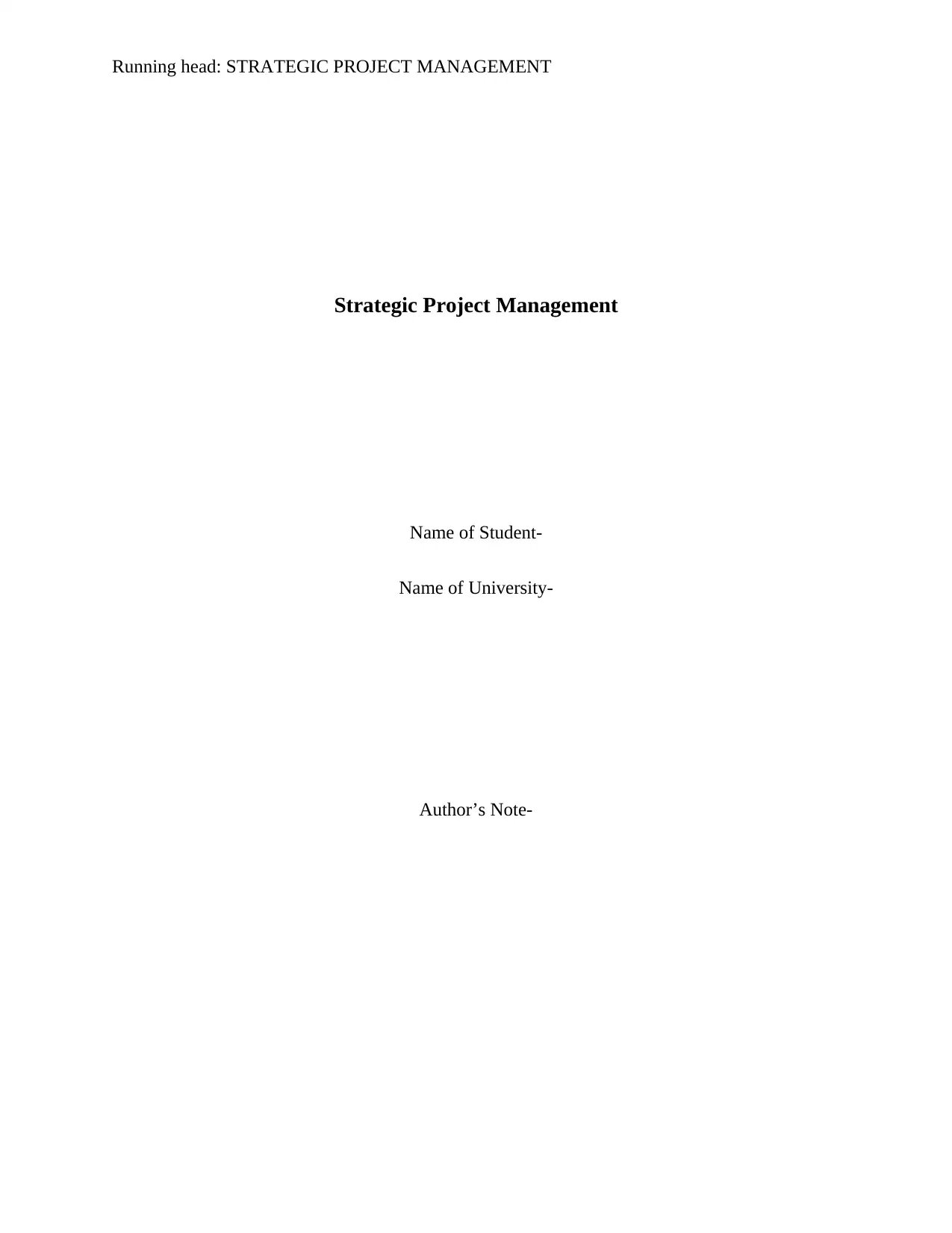
Running head: STRATEGIC PROJECT MANAGEMENT
Strategic Project Management
Name of Student-
Name of University-
Author’s Note-
Strategic Project Management
Name of Student-
Name of University-
Author’s Note-
Secure Best Marks with AI Grader
Need help grading? Try our AI Grader for instant feedback on your assignments.
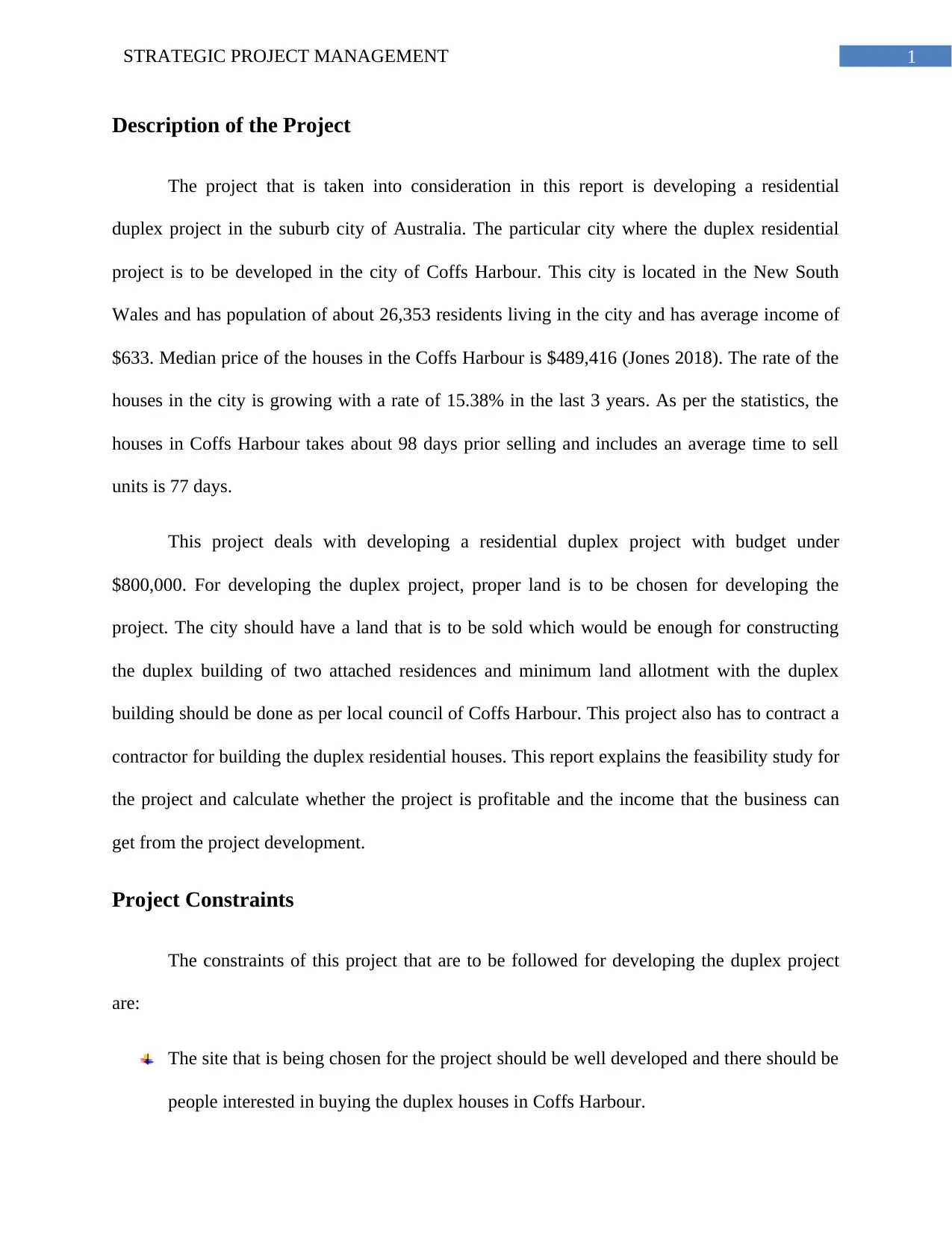
1STRATEGIC PROJECT MANAGEMENT
Description of the Project
The project that is taken into consideration in this report is developing a residential
duplex project in the suburb city of Australia. The particular city where the duplex residential
project is to be developed in the city of Coffs Harbour. This city is located in the New South
Wales and has population of about 26,353 residents living in the city and has average income of
$633. Median price of the houses in the Coffs Harbour is $489,416 (Jones 2018). The rate of the
houses in the city is growing with a rate of 15.38% in the last 3 years. As per the statistics, the
houses in Coffs Harbour takes about 98 days prior selling and includes an average time to sell
units is 77 days.
This project deals with developing a residential duplex project with budget under
$800,000. For developing the duplex project, proper land is to be chosen for developing the
project. The city should have a land that is to be sold which would be enough for constructing
the duplex building of two attached residences and minimum land allotment with the duplex
building should be done as per local council of Coffs Harbour. This project also has to contract a
contractor for building the duplex residential houses. This report explains the feasibility study for
the project and calculate whether the project is profitable and the income that the business can
get from the project development.
Project Constraints
The constraints of this project that are to be followed for developing the duplex project
are:
The site that is being chosen for the project should be well developed and there should be
people interested in buying the duplex houses in Coffs Harbour.
Description of the Project
The project that is taken into consideration in this report is developing a residential
duplex project in the suburb city of Australia. The particular city where the duplex residential
project is to be developed in the city of Coffs Harbour. This city is located in the New South
Wales and has population of about 26,353 residents living in the city and has average income of
$633. Median price of the houses in the Coffs Harbour is $489,416 (Jones 2018). The rate of the
houses in the city is growing with a rate of 15.38% in the last 3 years. As per the statistics, the
houses in Coffs Harbour takes about 98 days prior selling and includes an average time to sell
units is 77 days.
This project deals with developing a residential duplex project with budget under
$800,000. For developing the duplex project, proper land is to be chosen for developing the
project. The city should have a land that is to be sold which would be enough for constructing
the duplex building of two attached residences and minimum land allotment with the duplex
building should be done as per local council of Coffs Harbour. This project also has to contract a
contractor for building the duplex residential houses. This report explains the feasibility study for
the project and calculate whether the project is profitable and the income that the business can
get from the project development.
Project Constraints
The constraints of this project that are to be followed for developing the duplex project
are:
The site that is being chosen for the project should be well developed and there should be
people interested in buying the duplex houses in Coffs Harbour.
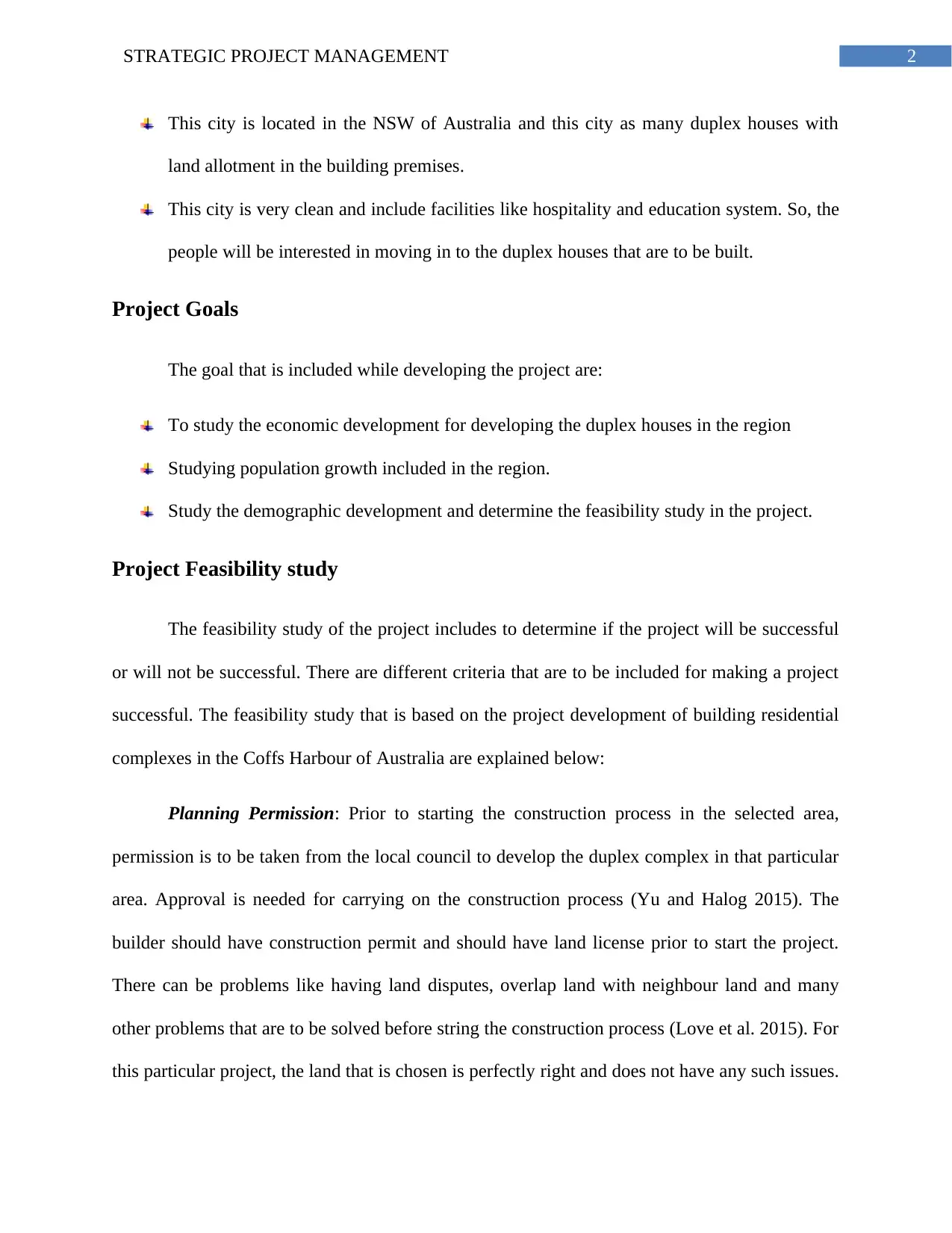
2STRATEGIC PROJECT MANAGEMENT
This city is located in the NSW of Australia and this city as many duplex houses with
land allotment in the building premises.
This city is very clean and include facilities like hospitality and education system. So, the
people will be interested in moving in to the duplex houses that are to be built.
Project Goals
The goal that is included while developing the project are:
To study the economic development for developing the duplex houses in the region
Studying population growth included in the region.
Study the demographic development and determine the feasibility study in the project.
Project Feasibility study
The feasibility study of the project includes to determine if the project will be successful
or will not be successful. There are different criteria that are to be included for making a project
successful. The feasibility study that is based on the project development of building residential
complexes in the Coffs Harbour of Australia are explained below:
Planning Permission: Prior to starting the construction process in the selected area,
permission is to be taken from the local council to develop the duplex complex in that particular
area. Approval is needed for carrying on the construction process (Yu and Halog 2015). The
builder should have construction permit and should have land license prior to start the project.
There can be problems like having land disputes, overlap land with neighbour land and many
other problems that are to be solved before string the construction process (Love et al. 2015). For
this particular project, the land that is chosen is perfectly right and does not have any such issues.
This city is located in the NSW of Australia and this city as many duplex houses with
land allotment in the building premises.
This city is very clean and include facilities like hospitality and education system. So, the
people will be interested in moving in to the duplex houses that are to be built.
Project Goals
The goal that is included while developing the project are:
To study the economic development for developing the duplex houses in the region
Studying population growth included in the region.
Study the demographic development and determine the feasibility study in the project.
Project Feasibility study
The feasibility study of the project includes to determine if the project will be successful
or will not be successful. There are different criteria that are to be included for making a project
successful. The feasibility study that is based on the project development of building residential
complexes in the Coffs Harbour of Australia are explained below:
Planning Permission: Prior to starting the construction process in the selected area,
permission is to be taken from the local council to develop the duplex complex in that particular
area. Approval is needed for carrying on the construction process (Yu and Halog 2015). The
builder should have construction permit and should have land license prior to start the project.
There can be problems like having land disputes, overlap land with neighbour land and many
other problems that are to be solved before string the construction process (Love et al. 2015). For
this particular project, the land that is chosen is perfectly right and does not have any such issues.
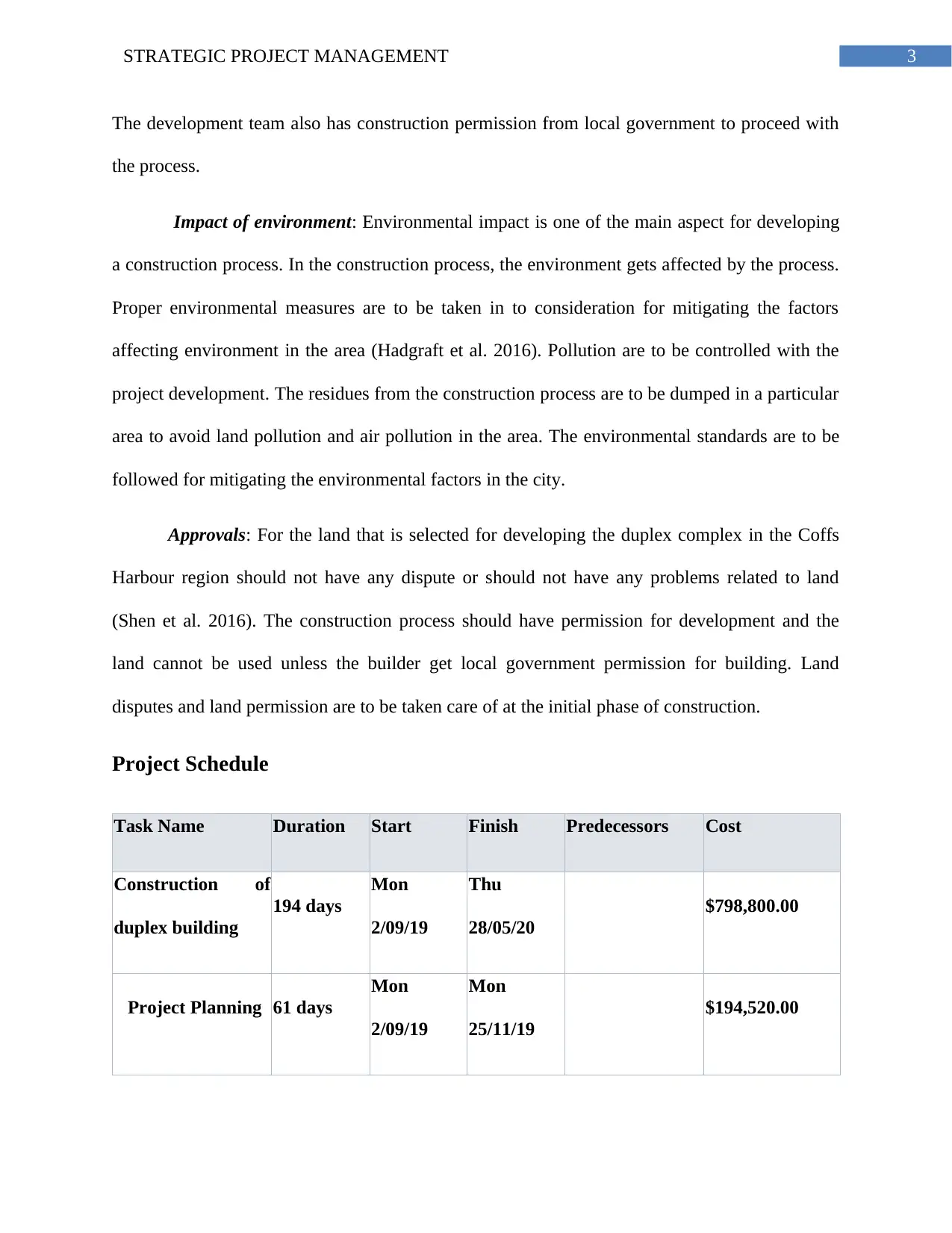
3STRATEGIC PROJECT MANAGEMENT
The development team also has construction permission from local government to proceed with
the process.
Impact of environment: Environmental impact is one of the main aspect for developing
a construction process. In the construction process, the environment gets affected by the process.
Proper environmental measures are to be taken in to consideration for mitigating the factors
affecting environment in the area (Hadgraft et al. 2016). Pollution are to be controlled with the
project development. The residues from the construction process are to be dumped in a particular
area to avoid land pollution and air pollution in the area. The environmental standards are to be
followed for mitigating the environmental factors in the city.
Approvals: For the land that is selected for developing the duplex complex in the Coffs
Harbour region should not have any dispute or should not have any problems related to land
(Shen et al. 2016). The construction process should have permission for development and the
land cannot be used unless the builder get local government permission for building. Land
disputes and land permission are to be taken care of at the initial phase of construction.
Project Schedule
Task Name Duration Start Finish Predecessors Cost
Construction of
duplex building
194 days
Mon
2/09/19
Thu
28/05/20
$798,800.00
Project Planning 61 days
Mon
2/09/19
Mon
25/11/19
$194,520.00
The development team also has construction permission from local government to proceed with
the process.
Impact of environment: Environmental impact is one of the main aspect for developing
a construction process. In the construction process, the environment gets affected by the process.
Proper environmental measures are to be taken in to consideration for mitigating the factors
affecting environment in the area (Hadgraft et al. 2016). Pollution are to be controlled with the
project development. The residues from the construction process are to be dumped in a particular
area to avoid land pollution and air pollution in the area. The environmental standards are to be
followed for mitigating the environmental factors in the city.
Approvals: For the land that is selected for developing the duplex complex in the Coffs
Harbour region should not have any dispute or should not have any problems related to land
(Shen et al. 2016). The construction process should have permission for development and the
land cannot be used unless the builder get local government permission for building. Land
disputes and land permission are to be taken care of at the initial phase of construction.
Project Schedule
Task Name Duration Start Finish Predecessors Cost
Construction of
duplex building
194 days
Mon
2/09/19
Thu
28/05/20
$798,800.00
Project Planning 61 days
Mon
2/09/19
Mon
25/11/19
$194,520.00
Secure Best Marks with AI Grader
Need help grading? Try our AI Grader for instant feedback on your assignments.
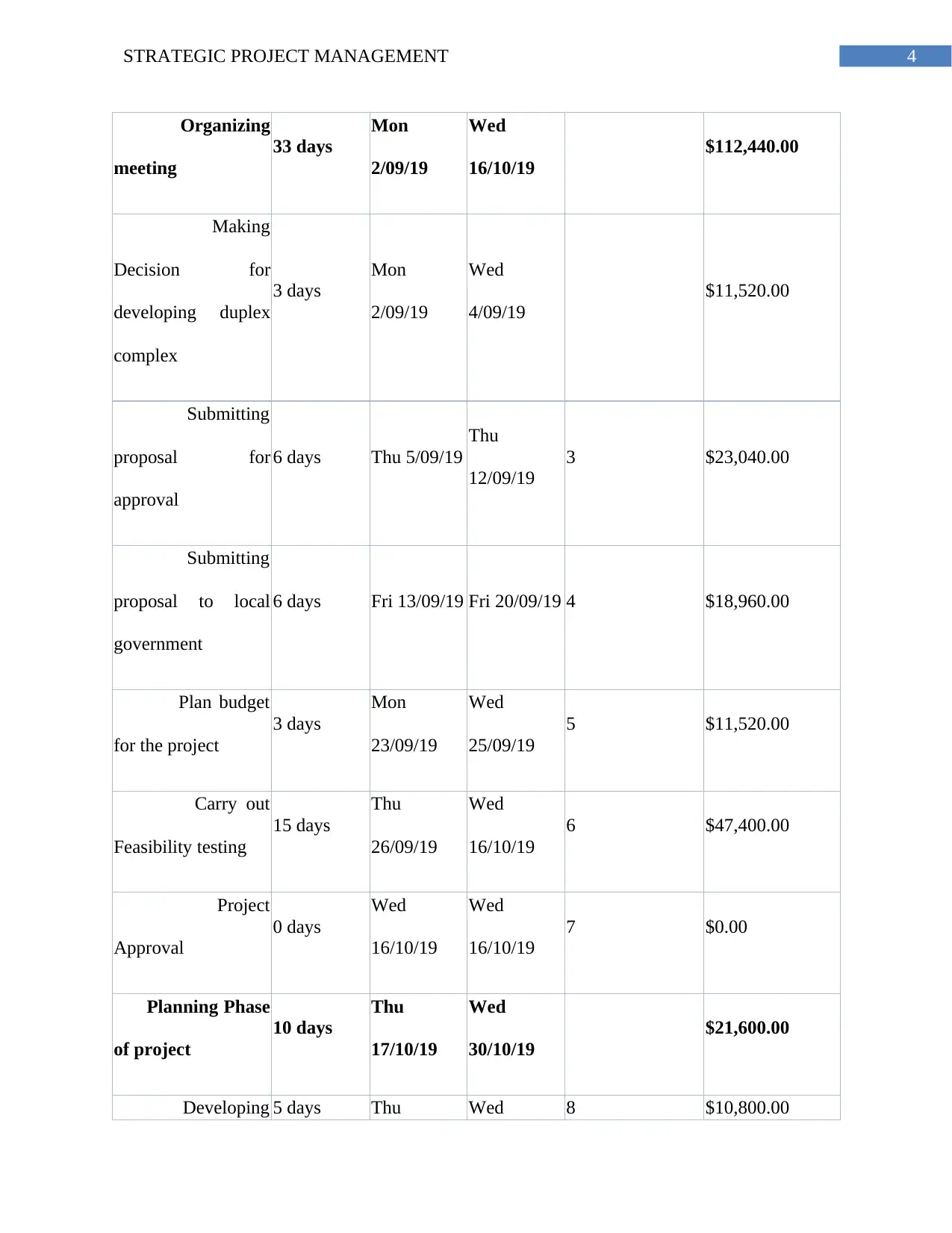
4STRATEGIC PROJECT MANAGEMENT
Organizing
meeting
33 days
Mon
2/09/19
Wed
16/10/19
$112,440.00
Making
Decision for
developing duplex
complex
3 days
Mon
2/09/19
Wed
4/09/19
$11,520.00
Submitting
proposal for
approval
6 days Thu 5/09/19
Thu
12/09/19
3 $23,040.00
Submitting
proposal to local
government
6 days Fri 13/09/19 Fri 20/09/19 4 $18,960.00
Plan budget
for the project
3 days
Mon
23/09/19
Wed
25/09/19
5 $11,520.00
Carry out
Feasibility testing
15 days
Thu
26/09/19
Wed
16/10/19
6 $47,400.00
Project
Approval
0 days
Wed
16/10/19
Wed
16/10/19
7 $0.00
Planning Phase
of project
10 days
Thu
17/10/19
Wed
30/10/19
$21,600.00
Developing 5 days Thu Wed 8 $10,800.00
Organizing
meeting
33 days
Mon
2/09/19
Wed
16/10/19
$112,440.00
Making
Decision for
developing duplex
complex
3 days
Mon
2/09/19
Wed
4/09/19
$11,520.00
Submitting
proposal for
approval
6 days Thu 5/09/19
Thu
12/09/19
3 $23,040.00
Submitting
proposal to local
government
6 days Fri 13/09/19 Fri 20/09/19 4 $18,960.00
Plan budget
for the project
3 days
Mon
23/09/19
Wed
25/09/19
5 $11,520.00
Carry out
Feasibility testing
15 days
Thu
26/09/19
Wed
16/10/19
6 $47,400.00
Project
Approval
0 days
Wed
16/10/19
Wed
16/10/19
7 $0.00
Planning Phase
of project
10 days
Thu
17/10/19
Wed
30/10/19
$21,600.00
Developing 5 days Thu Wed 8 $10,800.00
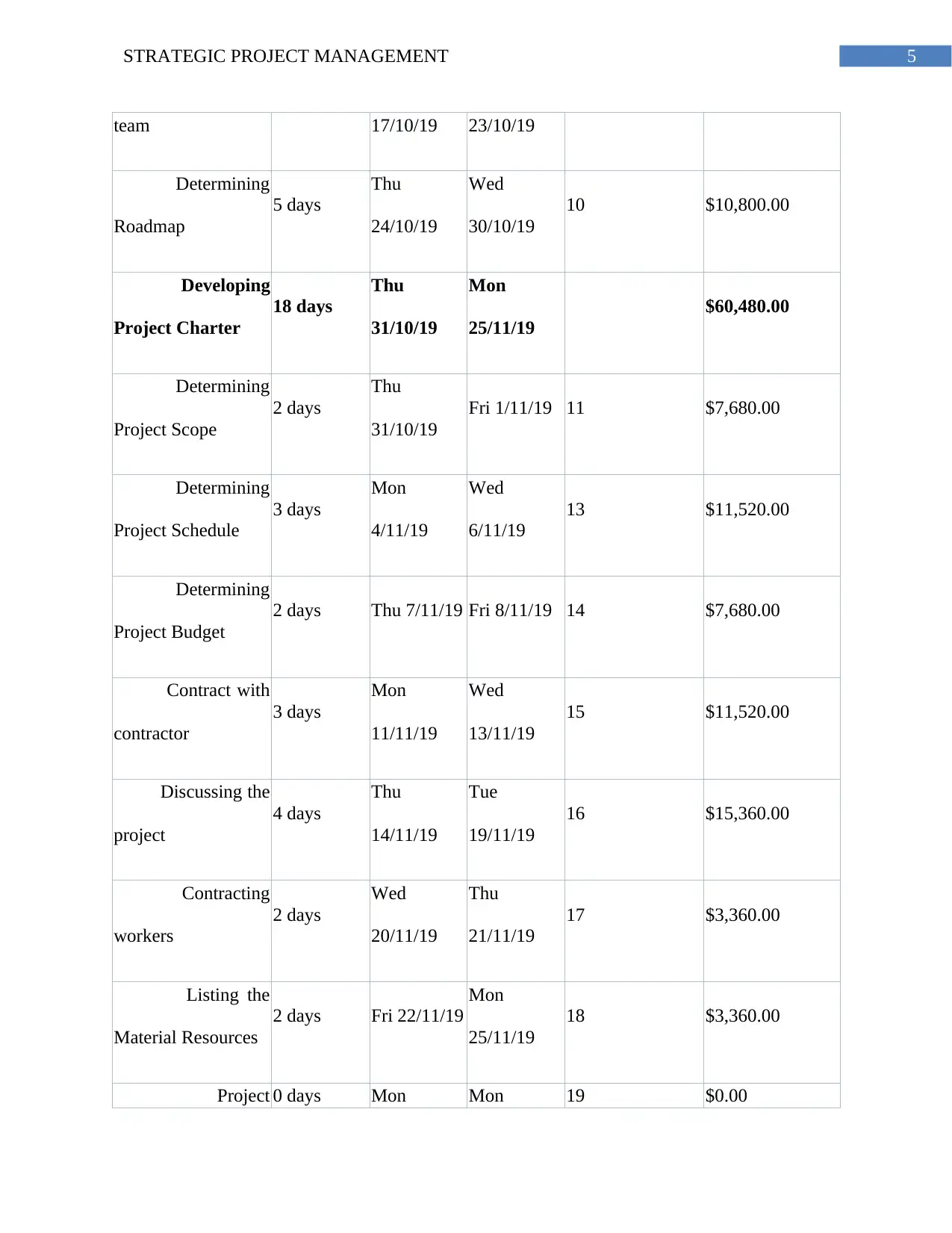
5STRATEGIC PROJECT MANAGEMENT
team 17/10/19 23/10/19
Determining
Roadmap
5 days
Thu
24/10/19
Wed
30/10/19
10 $10,800.00
Developing
Project Charter
18 days
Thu
31/10/19
Mon
25/11/19
$60,480.00
Determining
Project Scope
2 days
Thu
31/10/19
Fri 1/11/19 11 $7,680.00
Determining
Project Schedule
3 days
Mon
4/11/19
Wed
6/11/19
13 $11,520.00
Determining
Project Budget
2 days Thu 7/11/19 Fri 8/11/19 14 $7,680.00
Contract with
contractor
3 days
Mon
11/11/19
Wed
13/11/19
15 $11,520.00
Discussing the
project
4 days
Thu
14/11/19
Tue
19/11/19
16 $15,360.00
Contracting
workers
2 days
Wed
20/11/19
Thu
21/11/19
17 $3,360.00
Listing the
Material Resources
2 days Fri 22/11/19
Mon
25/11/19
18 $3,360.00
Project 0 days Mon Mon 19 $0.00
team 17/10/19 23/10/19
Determining
Roadmap
5 days
Thu
24/10/19
Wed
30/10/19
10 $10,800.00
Developing
Project Charter
18 days
Thu
31/10/19
Mon
25/11/19
$60,480.00
Determining
Project Scope
2 days
Thu
31/10/19
Fri 1/11/19 11 $7,680.00
Determining
Project Schedule
3 days
Mon
4/11/19
Wed
6/11/19
13 $11,520.00
Determining
Project Budget
2 days Thu 7/11/19 Fri 8/11/19 14 $7,680.00
Contract with
contractor
3 days
Mon
11/11/19
Wed
13/11/19
15 $11,520.00
Discussing the
project
4 days
Thu
14/11/19
Tue
19/11/19
16 $15,360.00
Contracting
workers
2 days
Wed
20/11/19
Thu
21/11/19
17 $3,360.00
Listing the
Material Resources
2 days Fri 22/11/19
Mon
25/11/19
18 $3,360.00
Project 0 days Mon Mon 19 $0.00
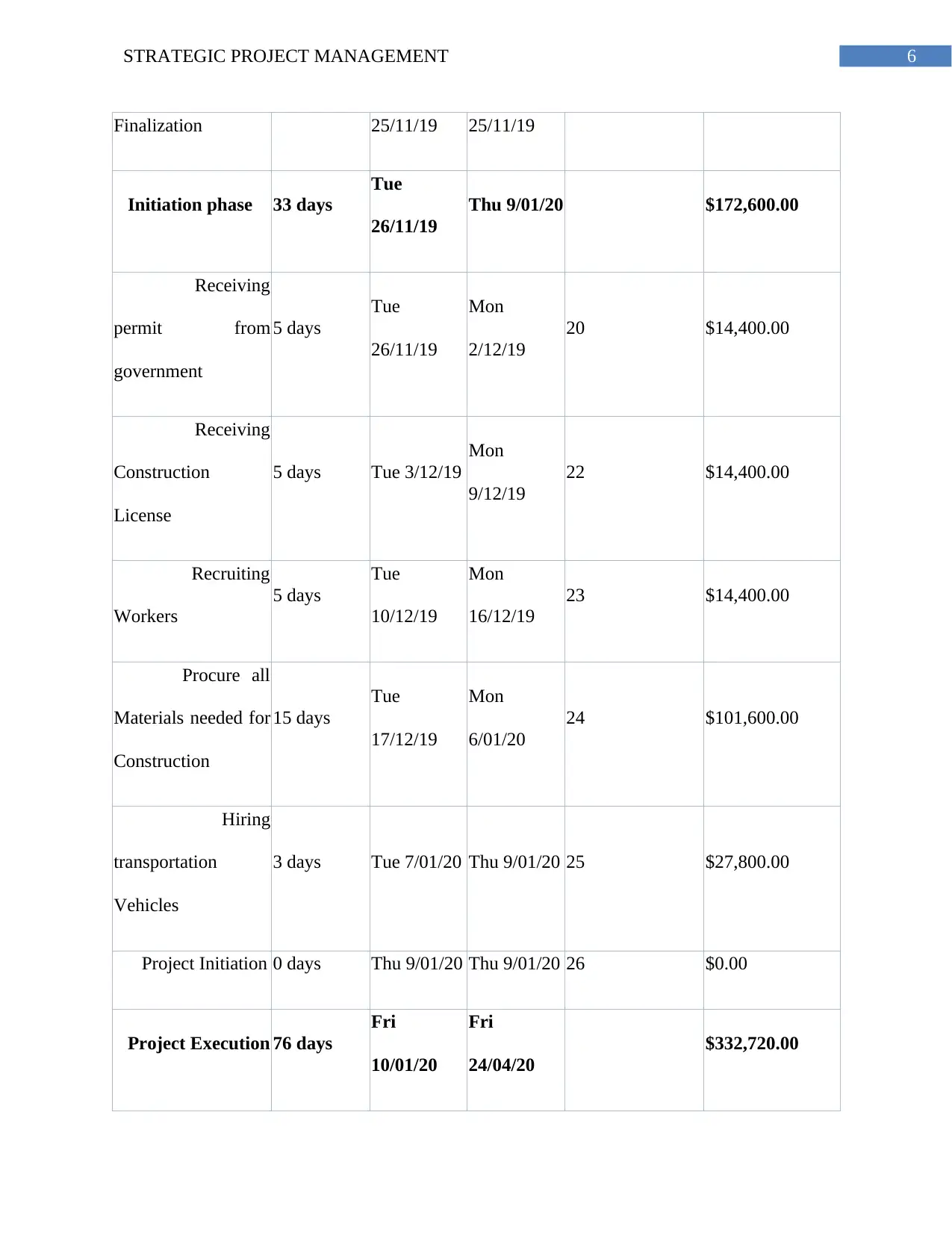
6STRATEGIC PROJECT MANAGEMENT
Finalization 25/11/19 25/11/19
Initiation phase 33 days
Tue
26/11/19
Thu 9/01/20 $172,600.00
Receiving
permit from
government
5 days
Tue
26/11/19
Mon
2/12/19
20 $14,400.00
Receiving
Construction
License
5 days Tue 3/12/19
Mon
9/12/19
22 $14,400.00
Recruiting
Workers
5 days
Tue
10/12/19
Mon
16/12/19
23 $14,400.00
Procure all
Materials needed for
Construction
15 days
Tue
17/12/19
Mon
6/01/20
24 $101,600.00
Hiring
transportation
Vehicles
3 days Tue 7/01/20 Thu 9/01/20 25 $27,800.00
Project Initiation 0 days Thu 9/01/20 Thu 9/01/20 26 $0.00
Project Execution 76 days
Fri
10/01/20
Fri
24/04/20
$332,720.00
Finalization 25/11/19 25/11/19
Initiation phase 33 days
Tue
26/11/19
Thu 9/01/20 $172,600.00
Receiving
permit from
government
5 days
Tue
26/11/19
Mon
2/12/19
20 $14,400.00
Receiving
Construction
License
5 days Tue 3/12/19
Mon
9/12/19
22 $14,400.00
Recruiting
Workers
5 days
Tue
10/12/19
Mon
16/12/19
23 $14,400.00
Procure all
Materials needed for
Construction
15 days
Tue
17/12/19
Mon
6/01/20
24 $101,600.00
Hiring
transportation
Vehicles
3 days Tue 7/01/20 Thu 9/01/20 25 $27,800.00
Project Initiation 0 days Thu 9/01/20 Thu 9/01/20 26 $0.00
Project Execution 76 days
Fri
10/01/20
Fri
24/04/20
$332,720.00
Paraphrase This Document
Need a fresh take? Get an instant paraphrase of this document with our AI Paraphraser
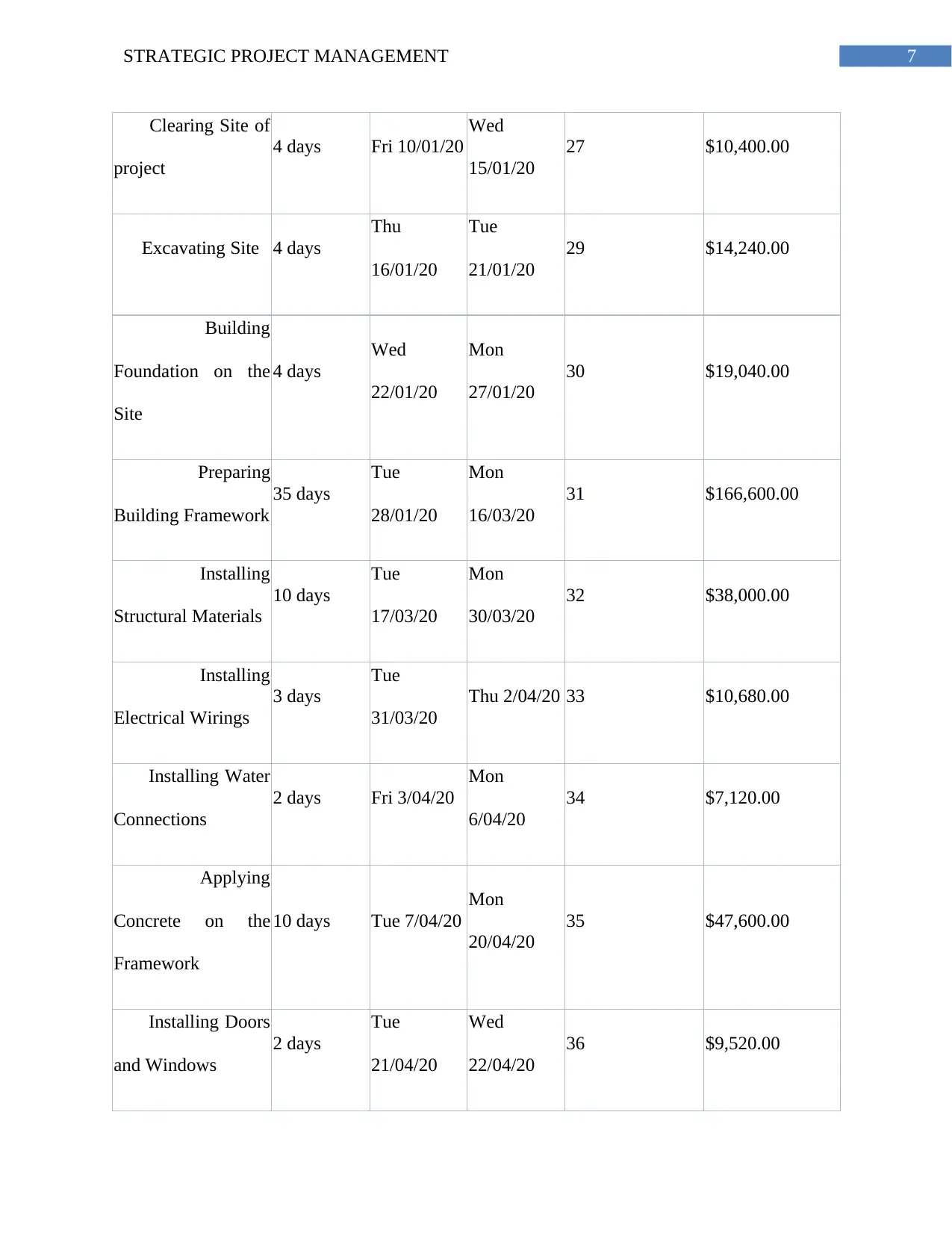
7STRATEGIC PROJECT MANAGEMENT
Clearing Site of
project
4 days Fri 10/01/20
Wed
15/01/20
27 $10,400.00
Excavating Site 4 days
Thu
16/01/20
Tue
21/01/20
29 $14,240.00
Building
Foundation on the
Site
4 days
Wed
22/01/20
Mon
27/01/20
30 $19,040.00
Preparing
Building Framework
35 days
Tue
28/01/20
Mon
16/03/20
31 $166,600.00
Installing
Structural Materials
10 days
Tue
17/03/20
Mon
30/03/20
32 $38,000.00
Installing
Electrical Wirings
3 days
Tue
31/03/20
Thu 2/04/20 33 $10,680.00
Installing Water
Connections
2 days Fri 3/04/20
Mon
6/04/20
34 $7,120.00
Applying
Concrete on the
Framework
10 days Tue 7/04/20
Mon
20/04/20
35 $47,600.00
Installing Doors
and Windows
2 days
Tue
21/04/20
Wed
22/04/20
36 $9,520.00
Clearing Site of
project
4 days Fri 10/01/20
Wed
15/01/20
27 $10,400.00
Excavating Site 4 days
Thu
16/01/20
Tue
21/01/20
29 $14,240.00
Building
Foundation on the
Site
4 days
Wed
22/01/20
Mon
27/01/20
30 $19,040.00
Preparing
Building Framework
35 days
Tue
28/01/20
Mon
16/03/20
31 $166,600.00
Installing
Structural Materials
10 days
Tue
17/03/20
Mon
30/03/20
32 $38,000.00
Installing
Electrical Wirings
3 days
Tue
31/03/20
Thu 2/04/20 33 $10,680.00
Installing Water
Connections
2 days Fri 3/04/20
Mon
6/04/20
34 $7,120.00
Applying
Concrete on the
Framework
10 days Tue 7/04/20
Mon
20/04/20
35 $47,600.00
Installing Doors
and Windows
2 days
Tue
21/04/20
Wed
22/04/20
36 $9,520.00
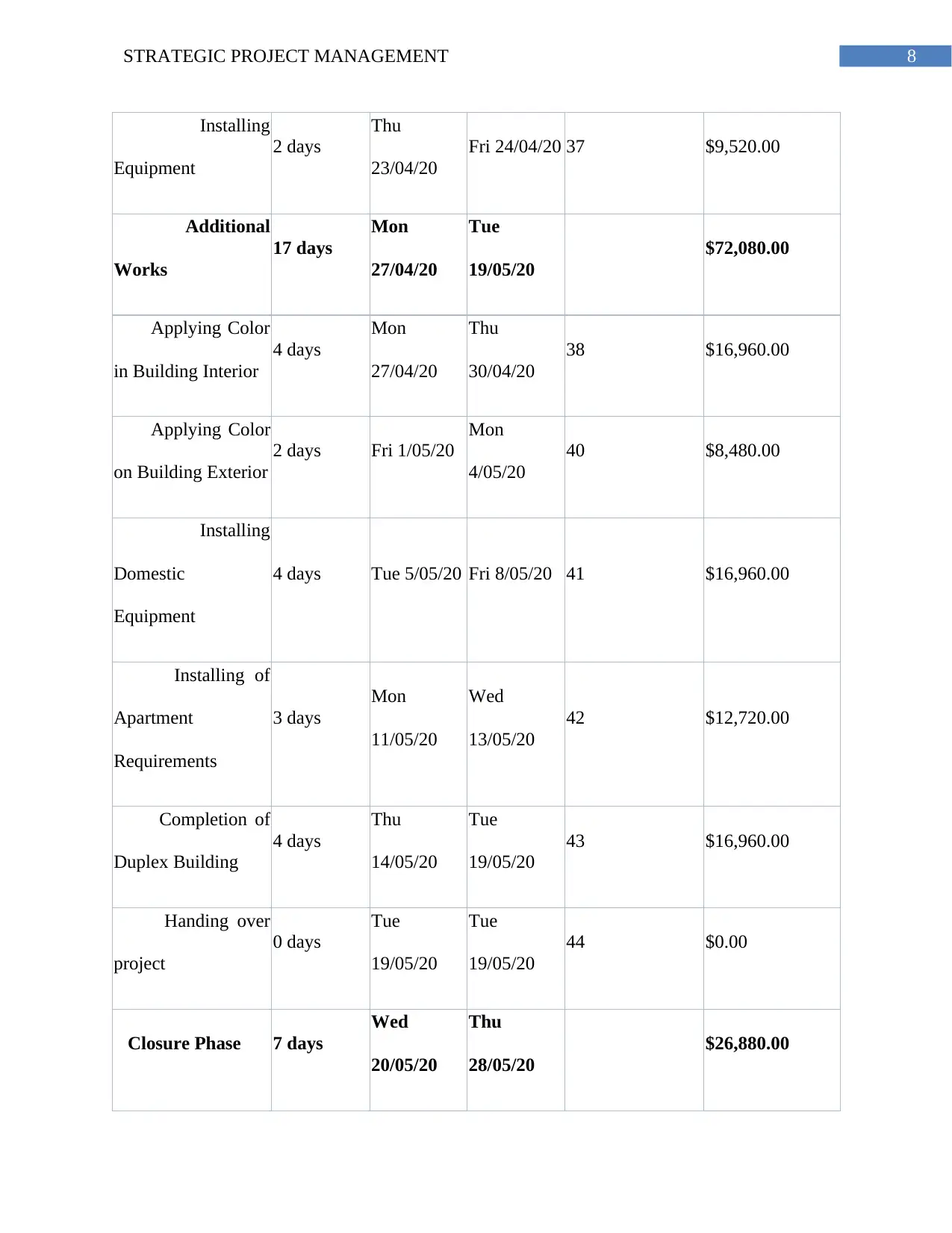
8STRATEGIC PROJECT MANAGEMENT
Installing
Equipment
2 days
Thu
23/04/20
Fri 24/04/20 37 $9,520.00
Additional
Works
17 days
Mon
27/04/20
Tue
19/05/20
$72,080.00
Applying Color
in Building Interior
4 days
Mon
27/04/20
Thu
30/04/20
38 $16,960.00
Applying Color
on Building Exterior
2 days Fri 1/05/20
Mon
4/05/20
40 $8,480.00
Installing
Domestic
Equipment
4 days Tue 5/05/20 Fri 8/05/20 41 $16,960.00
Installing of
Apartment
Requirements
3 days
Mon
11/05/20
Wed
13/05/20
42 $12,720.00
Completion of
Duplex Building
4 days
Thu
14/05/20
Tue
19/05/20
43 $16,960.00
Handing over
project
0 days
Tue
19/05/20
Tue
19/05/20
44 $0.00
Closure Phase 7 days
Wed
20/05/20
Thu
28/05/20
$26,880.00
Installing
Equipment
2 days
Thu
23/04/20
Fri 24/04/20 37 $9,520.00
Additional
Works
17 days
Mon
27/04/20
Tue
19/05/20
$72,080.00
Applying Color
in Building Interior
4 days
Mon
27/04/20
Thu
30/04/20
38 $16,960.00
Applying Color
on Building Exterior
2 days Fri 1/05/20
Mon
4/05/20
40 $8,480.00
Installing
Domestic
Equipment
4 days Tue 5/05/20 Fri 8/05/20 41 $16,960.00
Installing of
Apartment
Requirements
3 days
Mon
11/05/20
Wed
13/05/20
42 $12,720.00
Completion of
Duplex Building
4 days
Thu
14/05/20
Tue
19/05/20
43 $16,960.00
Handing over
project
0 days
Tue
19/05/20
Tue
19/05/20
44 $0.00
Closure Phase 7 days
Wed
20/05/20
Thu
28/05/20
$26,880.00
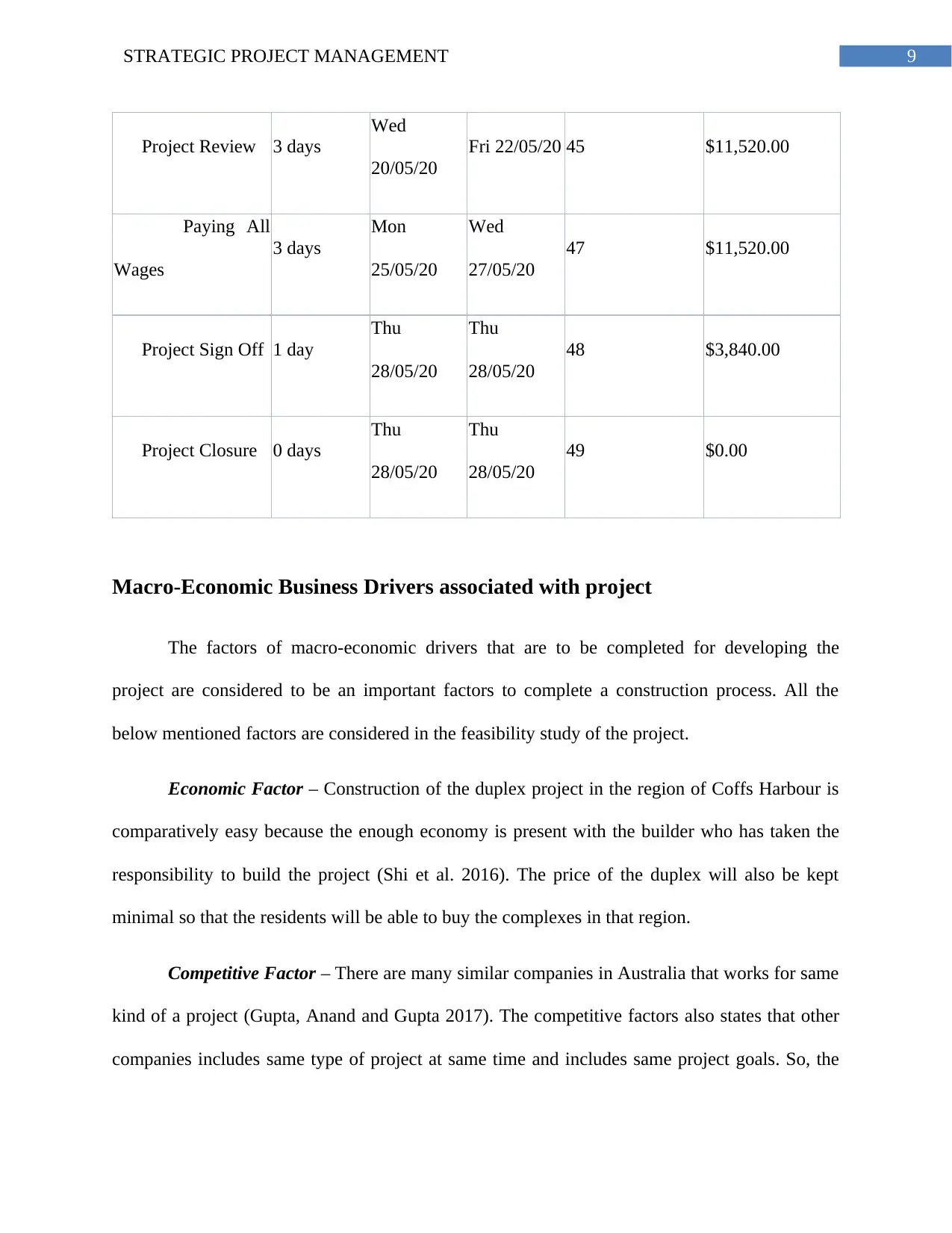
9STRATEGIC PROJECT MANAGEMENT
Project Review 3 days
Wed
20/05/20
Fri 22/05/20 45 $11,520.00
Paying All
Wages
3 days
Mon
25/05/20
Wed
27/05/20
47 $11,520.00
Project Sign Off 1 day
Thu
28/05/20
Thu
28/05/20
48 $3,840.00
Project Closure 0 days
Thu
28/05/20
Thu
28/05/20
49 $0.00
Macro-Economic Business Drivers associated with project
The factors of macro-economic drivers that are to be completed for developing the
project are considered to be an important factors to complete a construction process. All the
below mentioned factors are considered in the feasibility study of the project.
Economic Factor – Construction of the duplex project in the region of Coffs Harbour is
comparatively easy because the enough economy is present with the builder who has taken the
responsibility to build the project (Shi et al. 2016). The price of the duplex will also be kept
minimal so that the residents will be able to buy the complexes in that region.
Competitive Factor – There are many similar companies in Australia that works for same
kind of a project (Gupta, Anand and Gupta 2017). The competitive factors also states that other
companies includes same type of project at same time and includes same project goals. So, the
Project Review 3 days
Wed
20/05/20
Fri 22/05/20 45 $11,520.00
Paying All
Wages
3 days
Mon
25/05/20
Wed
27/05/20
47 $11,520.00
Project Sign Off 1 day
Thu
28/05/20
Thu
28/05/20
48 $3,840.00
Project Closure 0 days
Thu
28/05/20
Thu
28/05/20
49 $0.00
Macro-Economic Business Drivers associated with project
The factors of macro-economic drivers that are to be completed for developing the
project are considered to be an important factors to complete a construction process. All the
below mentioned factors are considered in the feasibility study of the project.
Economic Factor – Construction of the duplex project in the region of Coffs Harbour is
comparatively easy because the enough economy is present with the builder who has taken the
responsibility to build the project (Shi et al. 2016). The price of the duplex will also be kept
minimal so that the residents will be able to buy the complexes in that region.
Competitive Factor – There are many similar companies in Australia that works for same
kind of a project (Gupta, Anand and Gupta 2017). The competitive factors also states that other
companies includes same type of project at same time and includes same project goals. So, the
Secure Best Marks with AI Grader
Need help grading? Try our AI Grader for instant feedback on your assignments.
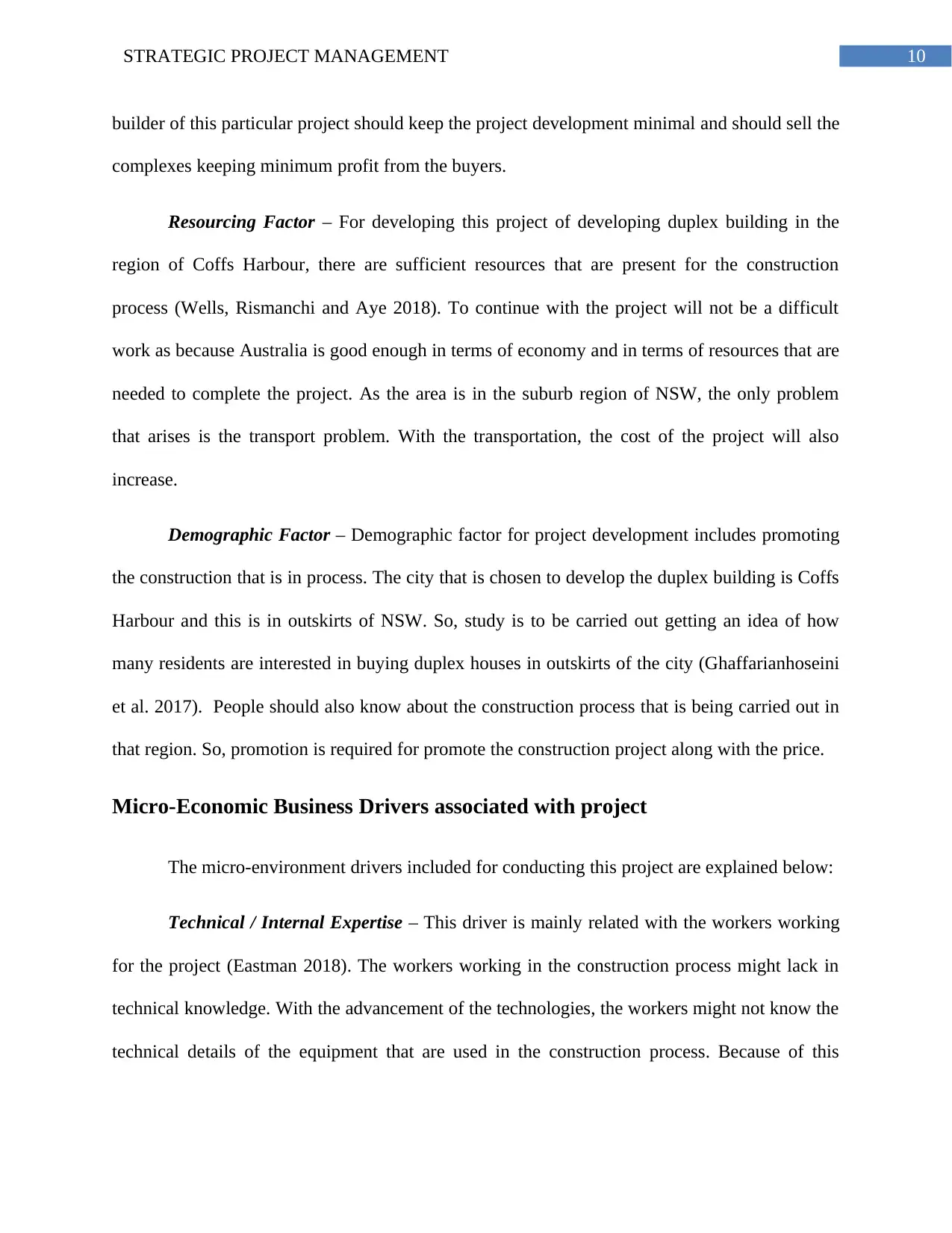
10STRATEGIC PROJECT MANAGEMENT
builder of this particular project should keep the project development minimal and should sell the
complexes keeping minimum profit from the buyers.
Resourcing Factor – For developing this project of developing duplex building in the
region of Coffs Harbour, there are sufficient resources that are present for the construction
process (Wells, Rismanchi and Aye 2018). To continue with the project will not be a difficult
work as because Australia is good enough in terms of economy and in terms of resources that are
needed to complete the project. As the area is in the suburb region of NSW, the only problem
that arises is the transport problem. With the transportation, the cost of the project will also
increase.
Demographic Factor – Demographic factor for project development includes promoting
the construction that is in process. The city that is chosen to develop the duplex building is Coffs
Harbour and this is in outskirts of NSW. So, study is to be carried out getting an idea of how
many residents are interested in buying duplex houses in outskirts of the city (Ghaffarianhoseini
et al. 2017). People should also know about the construction process that is being carried out in
that region. So, promotion is required for promote the construction project along with the price.
Micro-Economic Business Drivers associated with project
The micro-environment drivers included for conducting this project are explained below:
Technical / Internal Expertise – This driver is mainly related with the workers working
for the project (Eastman 2018). The workers working in the construction process might lack in
technical knowledge. With the advancement of the technologies, the workers might not know the
technical details of the equipment that are used in the construction process. Because of this
builder of this particular project should keep the project development minimal and should sell the
complexes keeping minimum profit from the buyers.
Resourcing Factor – For developing this project of developing duplex building in the
region of Coffs Harbour, there are sufficient resources that are present for the construction
process (Wells, Rismanchi and Aye 2018). To continue with the project will not be a difficult
work as because Australia is good enough in terms of economy and in terms of resources that are
needed to complete the project. As the area is in the suburb region of NSW, the only problem
that arises is the transport problem. With the transportation, the cost of the project will also
increase.
Demographic Factor – Demographic factor for project development includes promoting
the construction that is in process. The city that is chosen to develop the duplex building is Coffs
Harbour and this is in outskirts of NSW. So, study is to be carried out getting an idea of how
many residents are interested in buying duplex houses in outskirts of the city (Ghaffarianhoseini
et al. 2017). People should also know about the construction process that is being carried out in
that region. So, promotion is required for promote the construction project along with the price.
Micro-Economic Business Drivers associated with project
The micro-environment drivers included for conducting this project are explained below:
Technical / Internal Expertise – This driver is mainly related with the workers working
for the project (Eastman 2018). The workers working in the construction process might lack in
technical knowledge. With the advancement of the technologies, the workers might not know the
technical details of the equipment that are used in the construction process. Because of this
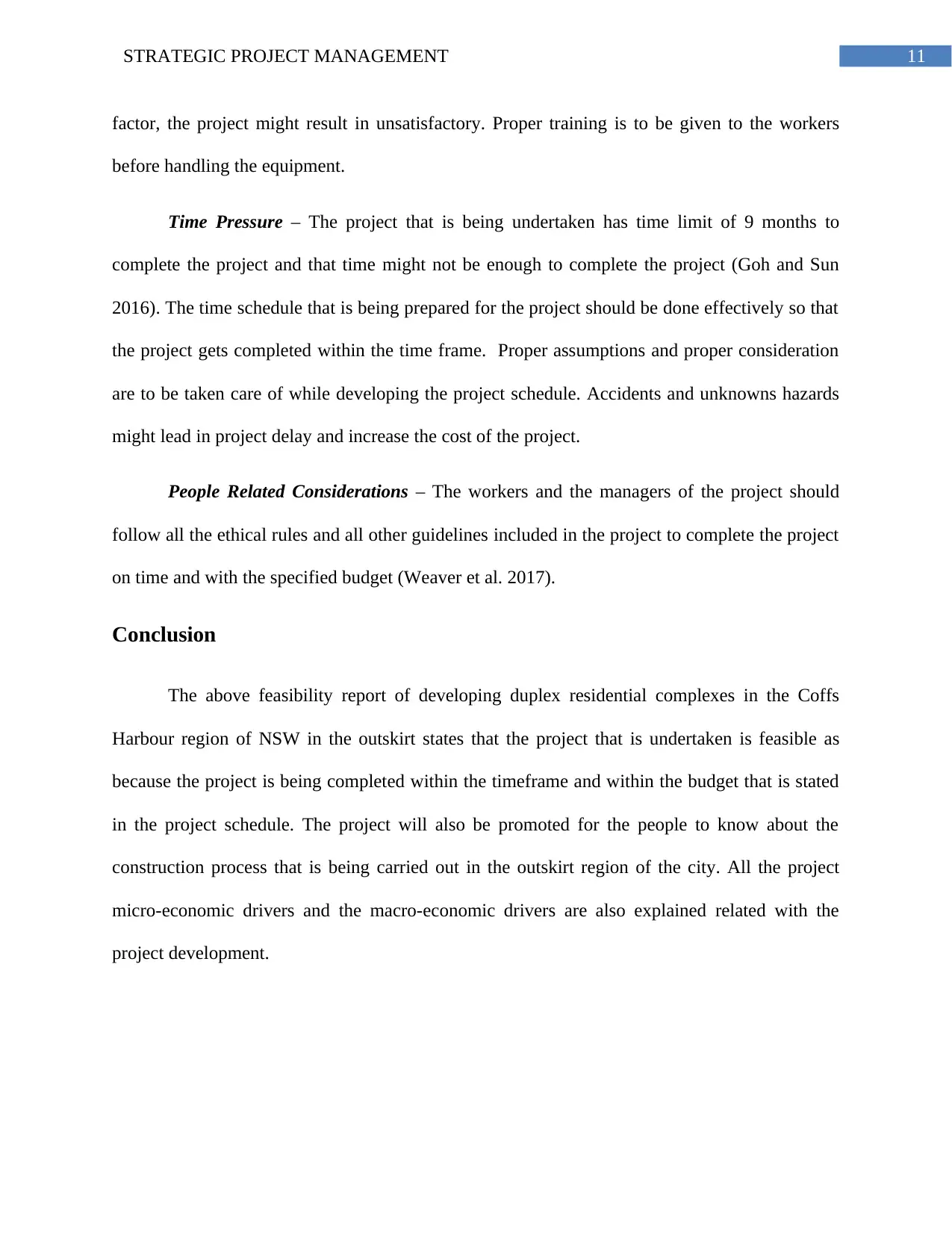
11STRATEGIC PROJECT MANAGEMENT
factor, the project might result in unsatisfactory. Proper training is to be given to the workers
before handling the equipment.
Time Pressure – The project that is being undertaken has time limit of 9 months to
complete the project and that time might not be enough to complete the project (Goh and Sun
2016). The time schedule that is being prepared for the project should be done effectively so that
the project gets completed within the time frame. Proper assumptions and proper consideration
are to be taken care of while developing the project schedule. Accidents and unknowns hazards
might lead in project delay and increase the cost of the project.
People Related Considerations – The workers and the managers of the project should
follow all the ethical rules and all other guidelines included in the project to complete the project
on time and with the specified budget (Weaver et al. 2017).
Conclusion
The above feasibility report of developing duplex residential complexes in the Coffs
Harbour region of NSW in the outskirt states that the project that is undertaken is feasible as
because the project is being completed within the timeframe and within the budget that is stated
in the project schedule. The project will also be promoted for the people to know about the
construction process that is being carried out in the outskirt region of the city. All the project
micro-economic drivers and the macro-economic drivers are also explained related with the
project development.
factor, the project might result in unsatisfactory. Proper training is to be given to the workers
before handling the equipment.
Time Pressure – The project that is being undertaken has time limit of 9 months to
complete the project and that time might not be enough to complete the project (Goh and Sun
2016). The time schedule that is being prepared for the project should be done effectively so that
the project gets completed within the time frame. Proper assumptions and proper consideration
are to be taken care of while developing the project schedule. Accidents and unknowns hazards
might lead in project delay and increase the cost of the project.
People Related Considerations – The workers and the managers of the project should
follow all the ethical rules and all other guidelines included in the project to complete the project
on time and with the specified budget (Weaver et al. 2017).
Conclusion
The above feasibility report of developing duplex residential complexes in the Coffs
Harbour region of NSW in the outskirt states that the project that is undertaken is feasible as
because the project is being completed within the timeframe and within the budget that is stated
in the project schedule. The project will also be promoted for the people to know about the
construction process that is being carried out in the outskirt region of the city. All the project
micro-economic drivers and the macro-economic drivers are also explained related with the
project development.
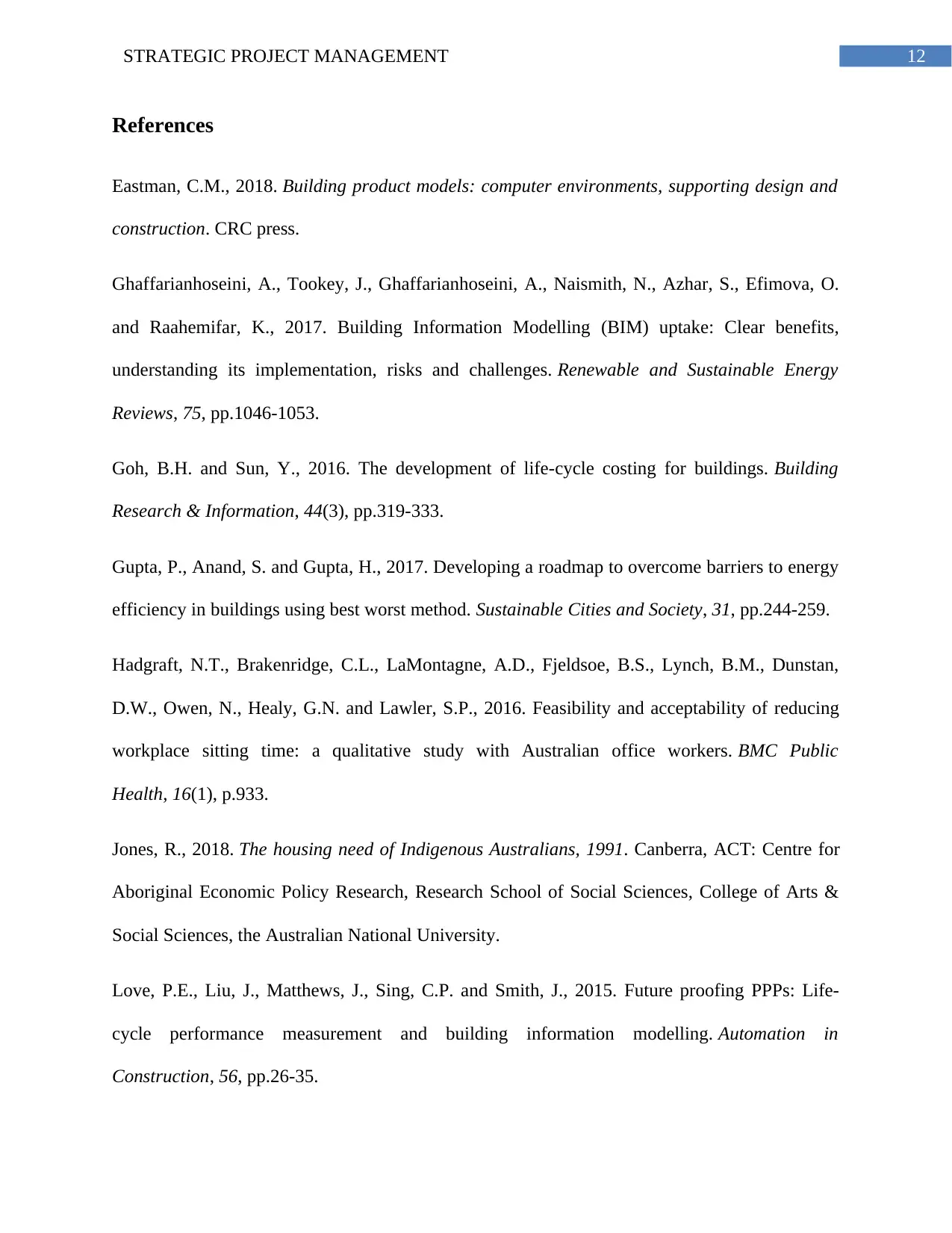
12STRATEGIC PROJECT MANAGEMENT
References
Eastman, C.M., 2018. Building product models: computer environments, supporting design and
construction. CRC press.
Ghaffarianhoseini, A., Tookey, J., Ghaffarianhoseini, A., Naismith, N., Azhar, S., Efimova, O.
and Raahemifar, K., 2017. Building Information Modelling (BIM) uptake: Clear benefits,
understanding its implementation, risks and challenges. Renewable and Sustainable Energy
Reviews, 75, pp.1046-1053.
Goh, B.H. and Sun, Y., 2016. The development of life-cycle costing for buildings. Building
Research & Information, 44(3), pp.319-333.
Gupta, P., Anand, S. and Gupta, H., 2017. Developing a roadmap to overcome barriers to energy
efficiency in buildings using best worst method. Sustainable Cities and Society, 31, pp.244-259.
Hadgraft, N.T., Brakenridge, C.L., LaMontagne, A.D., Fjeldsoe, B.S., Lynch, B.M., Dunstan,
D.W., Owen, N., Healy, G.N. and Lawler, S.P., 2016. Feasibility and acceptability of reducing
workplace sitting time: a qualitative study with Australian office workers. BMC Public
Health, 16(1), p.933.
Jones, R., 2018. The housing need of Indigenous Australians, 1991. Canberra, ACT: Centre for
Aboriginal Economic Policy Research, Research School of Social Sciences, College of Arts &
Social Sciences, the Australian National University.
Love, P.E., Liu, J., Matthews, J., Sing, C.P. and Smith, J., 2015. Future proofing PPPs: Life-
cycle performance measurement and building information modelling. Automation in
Construction, 56, pp.26-35.
References
Eastman, C.M., 2018. Building product models: computer environments, supporting design and
construction. CRC press.
Ghaffarianhoseini, A., Tookey, J., Ghaffarianhoseini, A., Naismith, N., Azhar, S., Efimova, O.
and Raahemifar, K., 2017. Building Information Modelling (BIM) uptake: Clear benefits,
understanding its implementation, risks and challenges. Renewable and Sustainable Energy
Reviews, 75, pp.1046-1053.
Goh, B.H. and Sun, Y., 2016. The development of life-cycle costing for buildings. Building
Research & Information, 44(3), pp.319-333.
Gupta, P., Anand, S. and Gupta, H., 2017. Developing a roadmap to overcome barriers to energy
efficiency in buildings using best worst method. Sustainable Cities and Society, 31, pp.244-259.
Hadgraft, N.T., Brakenridge, C.L., LaMontagne, A.D., Fjeldsoe, B.S., Lynch, B.M., Dunstan,
D.W., Owen, N., Healy, G.N. and Lawler, S.P., 2016. Feasibility and acceptability of reducing
workplace sitting time: a qualitative study with Australian office workers. BMC Public
Health, 16(1), p.933.
Jones, R., 2018. The housing need of Indigenous Australians, 1991. Canberra, ACT: Centre for
Aboriginal Economic Policy Research, Research School of Social Sciences, College of Arts &
Social Sciences, the Australian National University.
Love, P.E., Liu, J., Matthews, J., Sing, C.P. and Smith, J., 2015. Future proofing PPPs: Life-
cycle performance measurement and building information modelling. Automation in
Construction, 56, pp.26-35.
Paraphrase This Document
Need a fresh take? Get an instant paraphrase of this document with our AI Paraphraser
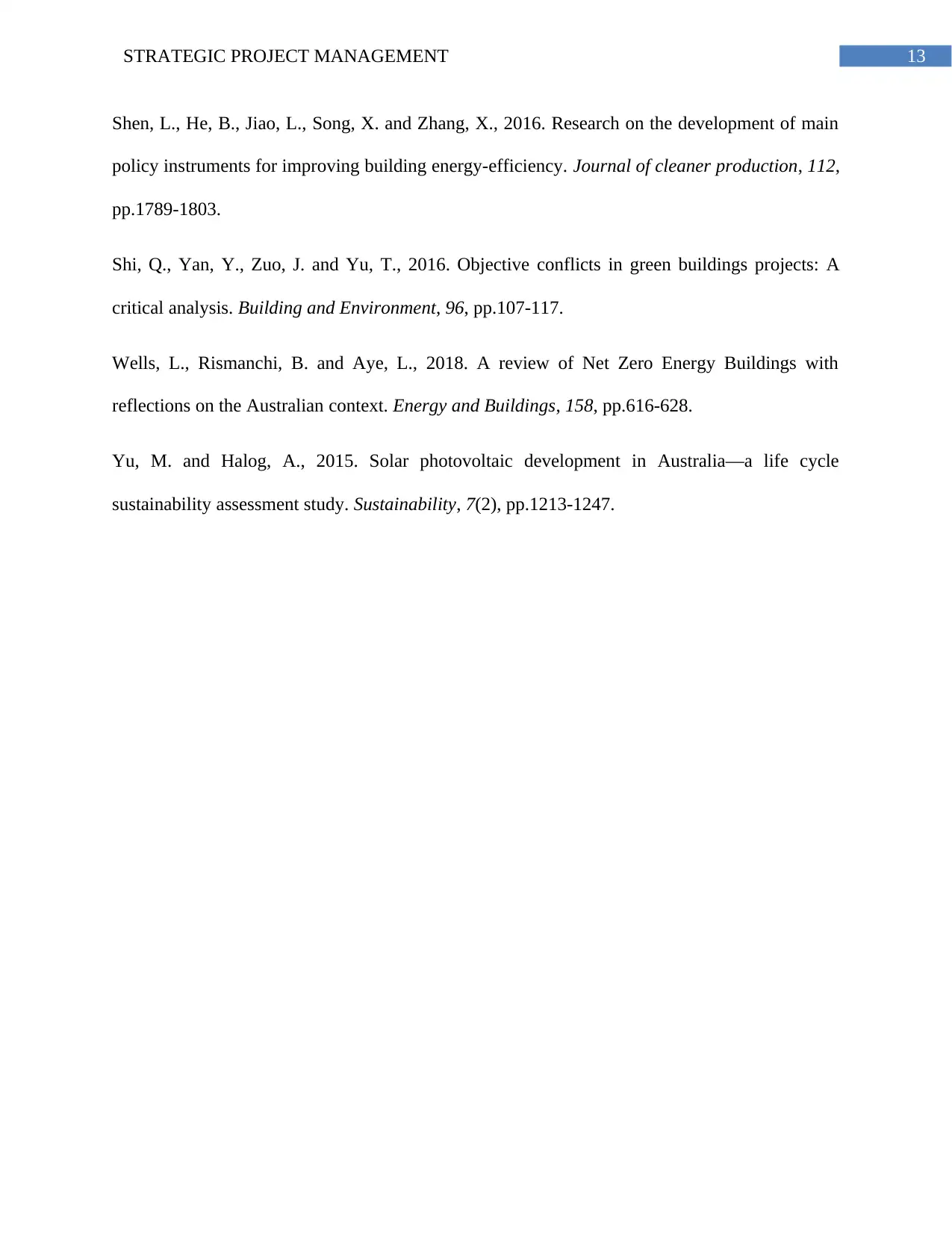
13STRATEGIC PROJECT MANAGEMENT
Shen, L., He, B., Jiao, L., Song, X. and Zhang, X., 2016. Research on the development of main
policy instruments for improving building energy-efficiency. Journal of cleaner production, 112,
pp.1789-1803.
Shi, Q., Yan, Y., Zuo, J. and Yu, T., 2016. Objective conflicts in green buildings projects: A
critical analysis. Building and Environment, 96, pp.107-117.
Wells, L., Rismanchi, B. and Aye, L., 2018. A review of Net Zero Energy Buildings with
reflections on the Australian context. Energy and Buildings, 158, pp.616-628.
Yu, M. and Halog, A., 2015. Solar photovoltaic development in Australia—a life cycle
sustainability assessment study. Sustainability, 7(2), pp.1213-1247.
Shen, L., He, B., Jiao, L., Song, X. and Zhang, X., 2016. Research on the development of main
policy instruments for improving building energy-efficiency. Journal of cleaner production, 112,
pp.1789-1803.
Shi, Q., Yan, Y., Zuo, J. and Yu, T., 2016. Objective conflicts in green buildings projects: A
critical analysis. Building and Environment, 96, pp.107-117.
Wells, L., Rismanchi, B. and Aye, L., 2018. A review of Net Zero Energy Buildings with
reflections on the Australian context. Energy and Buildings, 158, pp.616-628.
Yu, M. and Halog, A., 2015. Solar photovoltaic development in Australia—a life cycle
sustainability assessment study. Sustainability, 7(2), pp.1213-1247.
1 out of 14
Related Documents
Your All-in-One AI-Powered Toolkit for Academic Success.
+13062052269
info@desklib.com
Available 24*7 on WhatsApp / Email
![[object Object]](/_next/static/media/star-bottom.7253800d.svg)
Unlock your academic potential
© 2024 | Zucol Services PVT LTD | All rights reserved.





